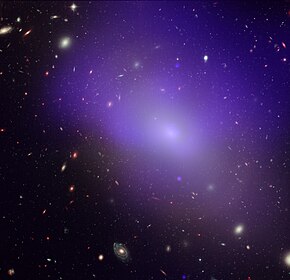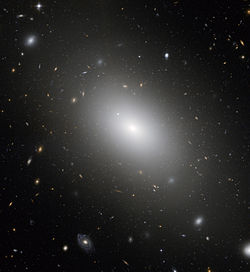NGC 1132
Appearance
| NGC 1132 | |
|---|---|
 A visible light image of NGS1132 with X-ray emission superimposed (rendered in blue) | |
| Observation data | |
| Right ascension | 02h 52m 51.82s |
| Declination | −01° 16′ 29.0″ |
| Redshift | 6,871 km/s |
| Apparent magnitude (B) | 13.9 |
| Characteristics | |
| Type | E |
| Other designations | |
| UGC 2359 | |
References: "NGC 1132". Simbad. Université de Strasbourg/CNRS. Retrieved September 24, 2020. | |
NGC 1132 is an elliptical galaxy located in the constellation Eridanus.[1] The galaxy was discovered by John Herschel on November 23, 1827.[2] It is located at a distance of about 318 million light-years away from Earth.[3]
NGC 1132 and nearby small galaxies are known as a "fossil group" that resulted from the merger of a group of galaxies.[1] It is notable for being the prototype example of the class of fossil galaxy groups.[4] The identification as a fossil group was made in 1999.[5] This group contains an enormous amount of dark matter and a large amount of hot gas that emits X-ray radiation.[6] The galaxy is surrounded by thousands of globular star clusters.[7]
References
- ^ a b "Gargantuan galaxy NGC 1132 - a cosmic fossil?". Hubble Space Telescope. NASA/ESA. February 5, 2008. Retrieved September 24, 2020.
- ^ "New General Catalog Objects: NGC 1100 - 1149". cseligman.com. Retrieved 2020-09-25.
- ^ Nowakowski, Tomasz (June 27, 2017). "Galaxy NGC 1132 has a disturbed hot halo, study finds". Phys.org. Science X. Retrieved September 24, 2020.
- ^ Alamo-Martínez1, K. A.; West1, M. J.; Blakeslee, J. P.; González-Lópezlira, R. A.; Jordán, A.; Gregg, M.; Côté, P.; Drinkwater, M. J.; van den Bergh, S. (October 2012). "Globular cluster systems in fossil groups: NGC 6482, NGC1132,and ESO 306-017" (PDF). Astronomy & Astrophysics. 546 (A15): A15. arXiv:1208.4060. Bibcode:2012A&A...546A..15A. doi:10.1051/0004-6361/201219285. S2CID 59132846. Retrieved September 24, 2020.
{{cite journal}}: CS1 maint: numeric names: authors list (link) - ^ Martínez, Álamo; Adriana, Karla (2015). Globular Clusters: Jewels to Trace the Structure of Galaxies (PDF). Universidad Nacional Autónoma de México. p. 65. ISBN 9786070268106.
- ^ "NGC 1132: A Mysterious Elliptical Galaxy". Chandra. NASA. February 5, 2008. Retrieved September 24, 2020.
- ^ "The Gargantuan Galaxy NGC 1132". Hubble. ESA. February 5, 2008. Retrieved September 24, 2020.
See also
![]() Media related to NGC 1132 at Wikimedia Commons
Media related to NGC 1132 at Wikimedia Commons

